For this review, let’s invent an imaginary couple and name them Bill and Amy. The year is 2012, and they decide to take a two year break and see a bit of the world. They plan to go to Asia, and soak in the sights and sounds of places like Indonesia, Vietnam, Cambodia, India and Hong Kong. Maybe some China too, time and money allowing. They were thinking of doing this since long, and now it was good a time as any.
So off they go, after months of careful planning. They love to run, so they buy a couple of brand new pairs, knowing that these countries might not stock their favorite shoe model, which so happened to be the Kinvara 3.
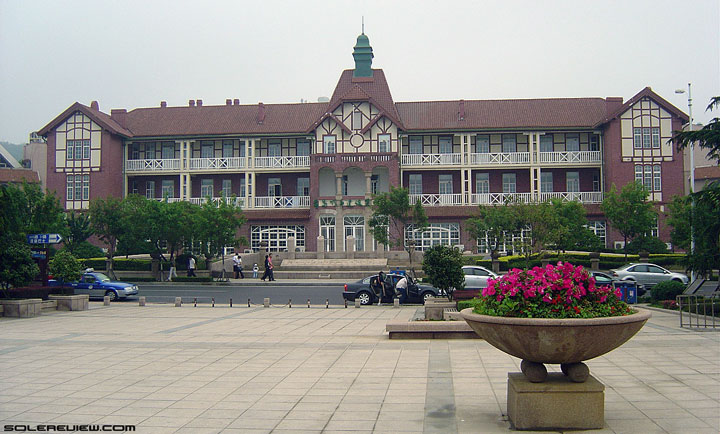
Examples of German architecture dot the Qindao promenade; it was briefly under German occupation in early 20th century. They also introduced the now famous Tsingtao beer.
Bill and Amy have a great time. They relax in serene Bali, marvel at the gridlocked traffic of Jakarta, discover delicious Vietnamese cuisine, fall in love with Angkor Vat, ride a train with open windows across the Indian landscape, and take in Hong Kong’s night skyline from their hotel room.
They also make it to China, where among other places, they travel far North-East to the beautiful city of Qingdao, and sip chilled beers of the same name while admiring the German architecture alongside the ocean walkway.
They also keep up with their running. The trusty Kinvara 3 serves Bill and Amy well. Its midsole blends in soft and firmness well, its heel-only Powergrid delivering cushioning within the boundaries of a stiff midsole.
Be it two miles along Mumbai’s Marine Drive in India, or a tenner inside the park on Hong Kong island, it makes short work of daily runs. Some of the ‘Flexfilm’ overlays start peeling, but nothing major.
Unfortunately, since Bill and Amy are forefoot strikers, after a year the Kinvara 3’s outsole is all worn out in the front, lacking in grip on wet pavement.
Luckily for them, they come across the newly launched 2013 Kinvara 4 in a Shanghai shop, which sees our friends through for another year. They like the Kinvara 4 too. Except for the upper change, it came with the familiar snappy ride of the K-3 which appealed to them so much.
All good things must come to an end, and Bill and Amy return stateside in 2014. Their Kinvara 4’s are absolutely trashed by now, so they go to their local running store and get a new pair of 5’s.
The shoe feels different when worn on the shop floor, but our Kinvara hugging brave-hearts don’t read much into it. They assume that it is going to end up feeling similar to the Kinvara 4, just in the way the K4 echoed the 3.
But after just 30 miles, they find out that the Kinvara 5 is worlds apart. First of all, the midsole is softer than before. The density seems to have changed, and there’s more splaying due to the deeper outsole groove below.
The upper on the other hand, feels more ‘built-up’. There is a newfangled thing called the ‘Prolock’, a pair of wide straps clasping either sides of the midfoot. The full length sleeve of the Kinvara 4 is gone now, and in its place is a gusset which limits itself to wrapping only the midfoot.
Their go-to shoe model now off the shelves, Bill and Amy are now in despair. Their local running store organises weekly runs, so our friends lament the demise of the ‘old Kinvara feel’. However, they are surprised (and somewhat dismayed) to find out that many other runners absolutely love the Kinvara 5.
The newly infused softness is much appreciated by many, and so is the relatively spacious forefoot fit. Everyone seems to like softer shoes now; there is a new kid in town called Hoka One One, and many brands have succumbed to taking a sip of Hoka Cola’s sweet, foamy softness, including Saucony.
Crestfallen, Bill and Amy start their search for a new shoe, and since they have heard so much about Hoka, they try on a few models. They don’t find the ‘maximal’ models appealing, but take a liking to the firmer Huaka, and settle for that model. They still run in the Kinvara 5, but it is no longer their favorite.
The moral of this whole story is – Saucony just lost two of their old Kinvara faithfuls.
But then, that’s always been the thing with running shoes. While Bill and Amy might have rejected the new Kinvara, many others – including long time Kinvara credit card swipers – will embrace the slew of changes. Polarizing opinions are part and parcel of running shoe releases, and whether a model is good or bad ends up being very, very subjective.
This is the same reason why many might not agree with the viewpoint in our reviews here – for the simple reason that everyone looks at shoes through a different tint of glasses.
This also indicates that the current trend of softened Kinvaras – namely v5 and v6 – might be transient, and who knows, the 2016 Kinvara 7 could mark the return of midsole firmness and upper minimalism. That will lead to another churn of Kinvara like’s and like nots, followed by a contradicting mix of much grumbling and praise. Such is the way the cookie crumbles.

Saucony changes its midsole design every two years, and the upper landscape once a year. The upper looks similar to K5 in many ways, so what changes are afoot?
The hero of this review however, is not the tale of Bill and Amy’s adventure, nor the previous Kinvara avatars, but the 2015 Kinvara 6. What newness does this update usher in?
Saucony, like many other brands, follows the tradition of biennial midsole updates. This means that their upper changes once a year, and the midsole/outsole combo every two. Within the running shoe industry, two notable exceptions are Brooks and Asics, who offer the norm of a complete annual upgrade for most of their popular models.
The Kinvara got a grandiose redesign last year, so as expected, 2015 is the time for an upper-only change while keeping the lower foundations intact. In that sense, while the Kinvara 5 fades away into sunset, its successor is heavy in design and function residue.
But as we’ve seen first hand very recently, even minute tinkering can lead a shoe down a slightly different path as far as upper fit is concerned, and the same can be said of the Kinvara 6.
First, let’s pick up where we left off, a refresher of sorts. The Kinvara 5 packed a couple of new things when it was launched, namely a softer-than-K4/K3 midsole and the ‘Pro-lock’ midfoot cinching system with a half-sleeve.
Back then it did not make sense, the ‘Pro-lock’ strap. But in hindset, when you factor in subsequent Triumph, Hurricane and Zealot ISOFIT rollouts, the reason behind introducing ‘Prolock’ becomes crystal clear.
You see, all brands take their ‘common design language’ philosophy very seriously. Which means that the powers-that-be decide on a unifying design or feature theme, and then that mandate percolates down the entire product line for a few years until it is replaced by something new and marketable.
In this particular example, Saucony’s newfound enthusiasm is directed towards snugger midfoot clasping – the ISOFIT being an embodiment of that ideal – and that cascades downstream to other models, either in function or visual detail.
Never mind the fact that a midfoot strap on a Kinvara is deemed gratuitous; what’s more important is total compliance with, and complete submission to the higher power of Saucony’s ‘one-design’ spirit.
Considering that context, the Kinvara 6’s Prolock can construed as the poor man’s ISOFIT, a watered-down version featuring a single independent midfoot panel instead of the entire floating cage.
But then, what’s a running shoe model update minus any change? That would be totally counter-intuitive, so enter the revised upper midfoot of the Kinvara 6.
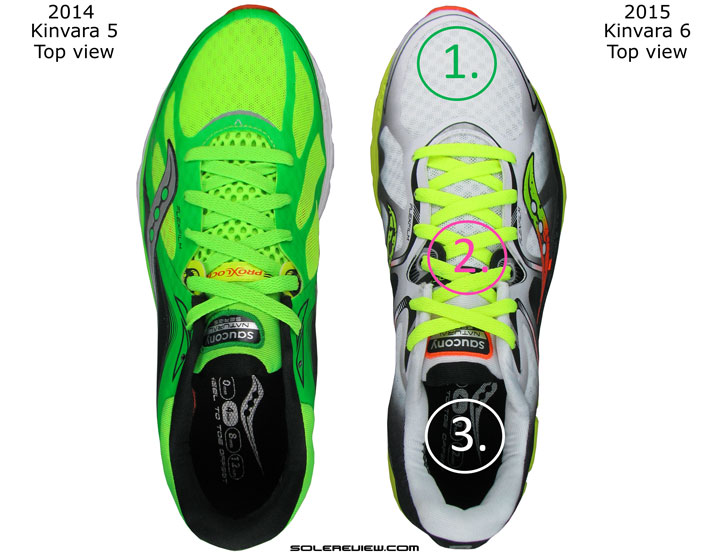
1) Higher toe-bumper molding delivers more vertical room 2) Prolock strap position has moved forward from last year 3) No change in collar fit and feel except for a slightly firmer Achilles dip
The midfoot strap has moved forward, a little further away from the tongue edge. In the last version (K5), the eyelets at the tip of the Prolock strap was aligned with the synthetic band on the tongue (with the ‘Prolock’ text written across).
The Kinvara 6 drives some distance between the two, so the eyelets close in on the foot a little ahead of the band.
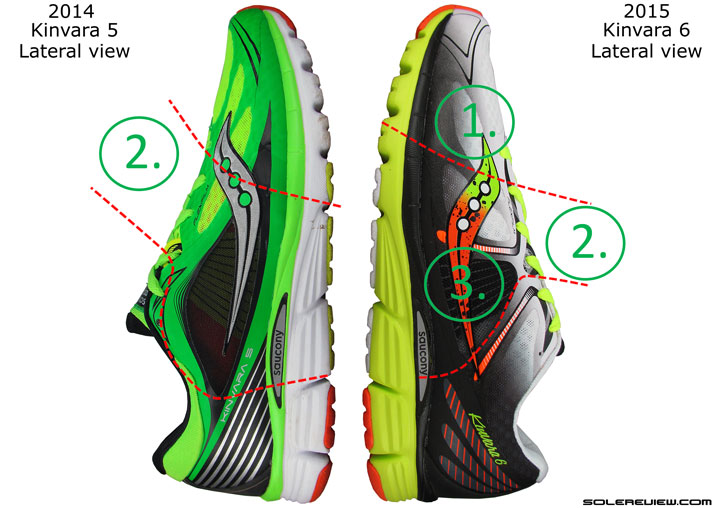
1) Flexfilm overlay design has changed 2) Dotted lines represent the shape of the inner sleeve. Notice how the Kinvara 6’s sleeve (right) extends further into forefoot 3) Smaller vented windows for 2015
But we deem the most important change to be the one which takes place inside the shoe. The internal half-sleeve of the Kinvara 6 is longer, extending further towards the forefoot than the Kinvara 5 ever did.
There’s a catch, though. This span increase applies more to the lateral (outer) side of the upper than the inner (medial) side, where the sleeving position isn’t all that different.
The result is a tighter upper, most of which is concentrated around the midfoot, with some spillover to the forefoot. Runners trading their Kinvara 5 for a 6 will feel this difference in fit, and that’s not the end of it.
The forefoot fit stays mostly unaltered, except for some increase of upper pressure at the base of the small toe. What has changed is toe box height, which on the Kinvara 6 is one which affords more vertical room near the shoe tip.
Flexfilm, the now Kinvara ubiquity in its fourth edition (Kinvara 3 was the first), forms the outer shell of the upper. It has changed from last year, shape shifting to a thicker layer instead of the melted-on feel of the K5’s Flexfilm.
The patterns are also thicker instead of the sinewy strips we last saw on Kinvara 5, and this makes the eyelet panel much thicker than Kinvara 5’s.
The stitch-less overlay around the toe bumper is higher and slightly raised upwards at the very tip. This steers the Kinvara 6’s toe box from the flatter profile of 2014 to a more rounded and spacious one. So there you have it; a contrasting combination of a tighter midfoot-early-forefoot and a more relaxed toe box.
Sizing stays true across both versions of the Kinvara, but runners with wide feet would do well to buy the older (and now cheaper) Kinvara 5 instead. For the popular Kinvara still continues to be peddled minus the option of widths. Surprising, given that it is now one of Saucony’s most commercial products.
Kinvara 5’s mesh was faux dual layered, a bonded combination of two fabric types. That has changed to a simpler format in 2015, a spacer fabric variety which looks and feels visually singular in layering.
We found the Kinvara 5’s inner environs to be more airy, and yes, the older construction allowed more air to pass through. Adding to that, what actually carries more weight in the ventilation department is the way the midfoot panels have been redesigned.
The window of open net-mesh over the Prolock strap on either sides has been dramatically reduced in area this year. While you could see the near-entirety of the Prolock panel from outside the Kinvara 5, that has been reduced to a mere glimpse on the K6. Perhaps this is another reason why the midfoot feels tighter, alongside a sensation of increased top-down lacing pressure.
By using thicker Flex-Film and a larger sleeve, the weight inches upwards a bit. It is 5 grams or 0.1 ounce heavier than Kinvara 5, which by the way, was heavier than the Kinvara 4 by the same margin. Naturally, this is just an attempt to state the empirical obvious, for none of this moves the needle in real world performance.
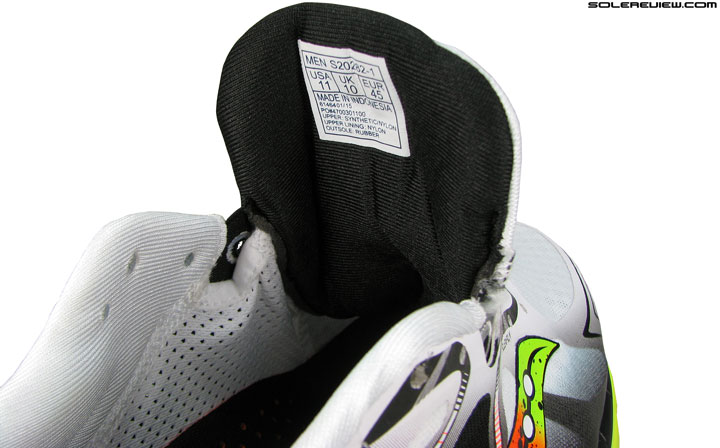
The tongue doesn’t have ears now (that sounds weird when you say it), and transforms into a simpler design.
Some parts and design elements are pinched over from the Kinvara 5, like the pairing of the lateral molded logo and a printed version medially, or the use of identical ‘Rundry’ collar and tongue lining.
Ok, there is a bit of a design shuffle on the tongue. The Kinvara 6’s tongue loses some padding and the Pikachu eared tongue flaps, turning it into a leaner version of its previous form.
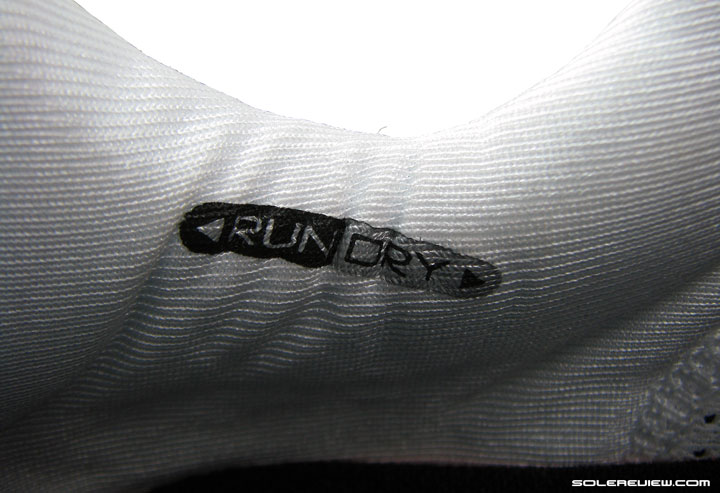
Rundry fabric used here, as was the case on the Kinvara 5. The Kinvara 4 used Hydramax. What’s the difference? Have no idea at all.
The upper heel is virtually unchanged. The level of fit is unchanged, and the foam padding intact. The structure is semi-rigid, by way of an internal heel counter which goes up only-halfway. The collar grips around in a relaxed way, a far cry from the narrower, focused feel of Kinvara 4’s heel. Memory foam pockets, remember?
What’s new is the amount of low-light visibility bits, which sees an upside on the Kinvara 6.

Besides the reflective thingy, the heel redesign also makes the Kinvara 6’s Achilles dip a tad firmer.
The reflective inserts on the lateral midsole, the outsole and tongue tip are exactly in the same places where Kinvara 5 left it.
An addition has been made on the upper heel, where a vertical strip contributes to extra visibility at night. All of these are fully reflective, no ‘faux’ or ’semi’ stuff here. Featuring adequate amount of reflective elements is an area where Saucony has traditionally been diligent at.
Are there any upper flaws to speak of? We’re not a fan of the half-sleeve, because it adds inconsistency to what could been a seam-free interior. It is attached flush with the collar lining, using flat-lock stitching to join itself. But the front isn’t, which means that the edges are rounded off with an additional layer of thin fabric seen in the picture here.
Since the edges don’t lie flush with rest of the lining, this creates a small bump on either sides. It feels like an excess fold in your socks which needs straightening out. Unlikely to chafe, but with memories of Kinvara 4’s full (and smoother) sleeve serving as a reference, this aspect comes across as an area which can be refined.

Some Kinvara 4 lovers might be scratching their heads with regards to what the Prolock’s value add is.
And the whole Prolock thing; it seems an unnecessary inclusion which delivers nothing substantial of value, not at all what it’s cracked up to be.
The last ask would be the option of widths, which now should be a default feature-set for mainstream models such as the Kinvara.
Looking at the sixth version of the Kinvara, it is pretty clear that it is based on the identical midsole platform as the K5. So all things being equal, both shoes should end up ditto ride-wise, right?
Except that they aren’t equal, never mind the legacy midsole. When we compared our K5 to the K6, the latter’s midsole was actually softer. Hard to express that in numerical terms (actually, you can if one uses a EVA durometer, which we don’t have) when inspected manually, but we’d say the Kinvara 6’s midsole foam is around 20% softer.
To sum up, the Kinvara has become progressively softer over the years. Coming to think of it, the 2014 Kinvara 5 took a quantum leap towards midsole cushy-ness, and the upward graph continues this year.
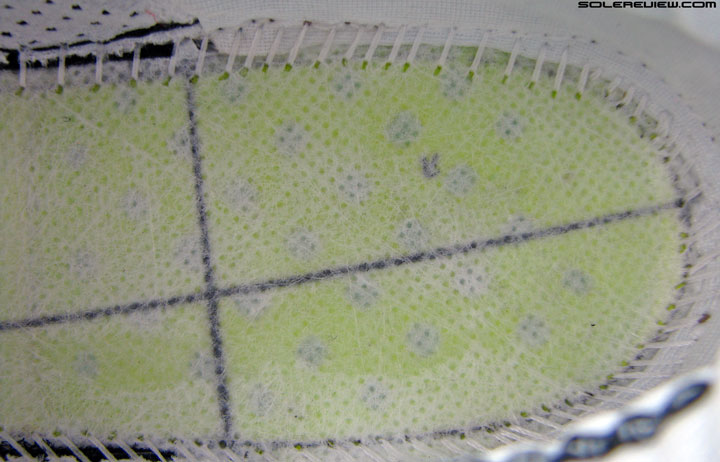
A sizable Saucony’s Powergrid is visible under the fabric lasting. We dropped some water in so that the fabric could stick to the foam.
This has a major effect on how the heel cushioning feels. The Kinvara 6, like all before it, uses a heel/midfoot only Powergrid insert – a softer foam which feels similar to Nike’s Lunarlon in texture. On firmer models such as the Kinvara 3 and 4, you could feel the cushioning at two distinct levels. You’d sense the Powergrid foam separately as first level padding, and then discern the firmer EVA base underneath.
That distinction has now become blurred, starting from the Kinvara 5, and more so on the Kinvara 6. As the non-Powergrid EVA’s softness increases, it starts matching up with the Powergrid insert when it comes to spongey-ness. So you no longer get the feeling that there’s a separate Powergrid inside, though in reality it 100% continues to be a part of the midsole.

Some minor updates on its reverse side, which includes no last markings on the heel and an inclusion of a surface texture.
From a performance perspective, the ride behavior is very, very similar to the Kinvara 5. Softly cushioned heel and forefoot, courtesy the midsole, the wider (and deeper) outsole groove+crash pad which splays under weight, and the removable insole. Ok, the insole is the same as Kinvara 5’s, but with subtle aesthetic changes such as removal of last markings and addition of a meshed texture underneath.
Transition was always the Kinvara’s forte, and the K6 does not disappoint. Though the midsole feel is split into forward and rear halves by use of the Powergrid, the feel is smooth and consistent.
The trick which achieves this is the substantial length of the Powergrid foam insert, which does not limit itself to the heel area but extends (forward) nearly halfway the length of the midsole. This prevents the abruptness of material otherwise created by a limited area heel insert – the Puma Ignite is an apt example of that folly.
Up in the front, increased softness leads to increased flexibility, so transitions require some footwork instead of a roll-off/rocker approach. This was one area in which the stiffer Kinvara’s (say 3 and 4) felt snappier, more touch and go if you will. So while we rate the quality of forefoot transition as good, the way in which it comes packaged differs from Kinvara 4’s and earlier.
Like the Kinvara 5, the inner side of the midsole has a flat sidewall, opposed to a grooved treatment on the lateral face. Consistent with how a lot of ‘neutral’ shoes work, there is a minor hint of lateral bias on rear-foot loading/landing.
Though this isn’t something which affects stability, it feels slightly less so than the planted feel of Kinvara 3 or 4 – a side note for those who plan to directly switch from the K4. And if the feel of under-arch support was important for you, know that the Kinvara 5 and 6’s midsole tapers down under the arch, compared to the slightly raised flare of K3 and K4. So you guessed correctly, lower arch-support feel on the new-generation K’s, for whatever you think it is worth.

Triangular rubber inserts mounted on midsole foam pods. Contraction occurs on footstrike or transition.
With an identical K5 midsole comes identical outsole design. Lateral heel coverage of carbon rubber, Saucony Jazz inspired triangular rubber embeds made of blown rubber, all familiar bits and pieces.
The triangular inserts are inlays mounted on raised midsole pods, so there’s some pistoning action there upon weight loading or footstrike.
So what can the Kinvara 6 be used for? That is a good question, and the answer will be an obvious generalization of the shoe’s potential.
We see the Kinvara as a good shoe to have as a daily trainer, one which meets the requirement of being low heel drop, lightweight and cushioned. It is padded but far from mushy, so the shoe isn’t a deterrent for faster runs, though Kinvara old timers might prefer the earlier versions for such workouts.
How about race day? We’d say yes to that too, for distances ranging from 5K to a marathon. Like we said, individual needs are subjective, but the Kinvara definitely has that range to perform when duty calls.
Next year should see a major overhaul of the Kinvara platform, as Saucony should introduce a refreshed midsole platform. What made the Kinvara 3 and 4 popular wasn’t the same for the Kinvara 5 and 6; so will the 2016 Kinvara 7 go back to its minimal design roots? One which put a fuss free upper over a base which felt economical to run in?
If that happens, Bill and Amy will happily approve.
(Disclaimer: For this review, Solereview bought the shoe at full US retail price.)
Looking to upgrade your older Saucony Kinvara 5 to the latest version, but not sure how the 2015 model compares? We can help here. The following infographic is a ready-reckoner for what changes you might expect in the new model vs. old. To make this more fun, we’ve put in a system of percentage match, which calculates a weighted average for a set of attributes.
A higher or lower match percentage is neither good or bad. The % number just tells you how similar or distanced the new shoe is from the previous version. Total match % is a result of weighted averages.




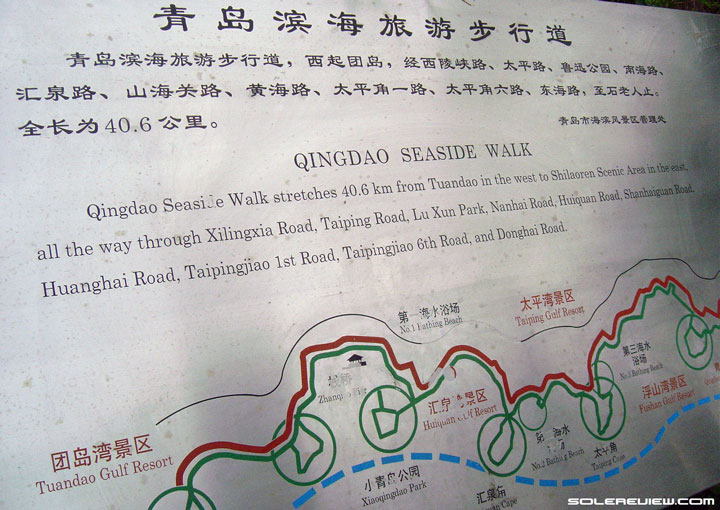
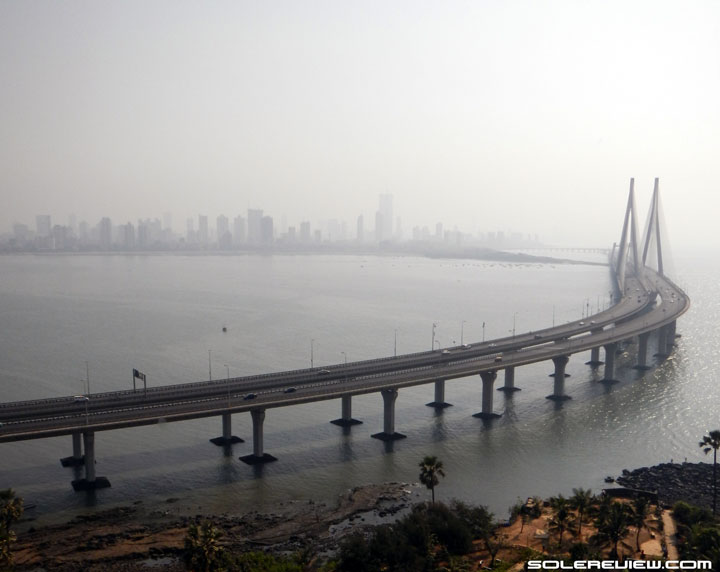
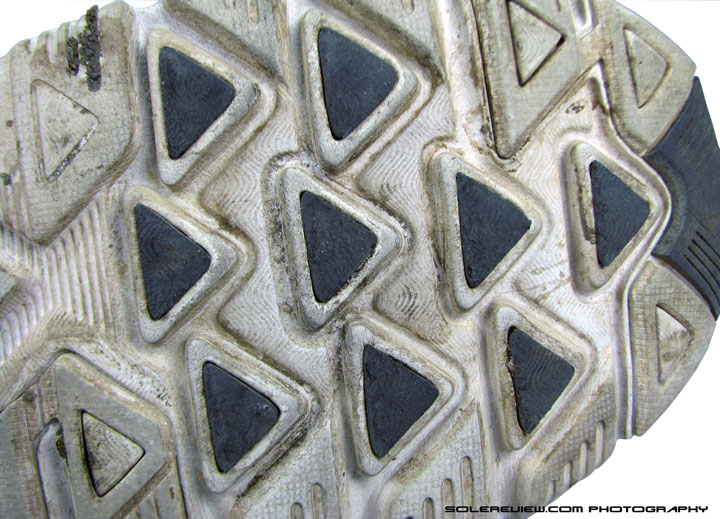





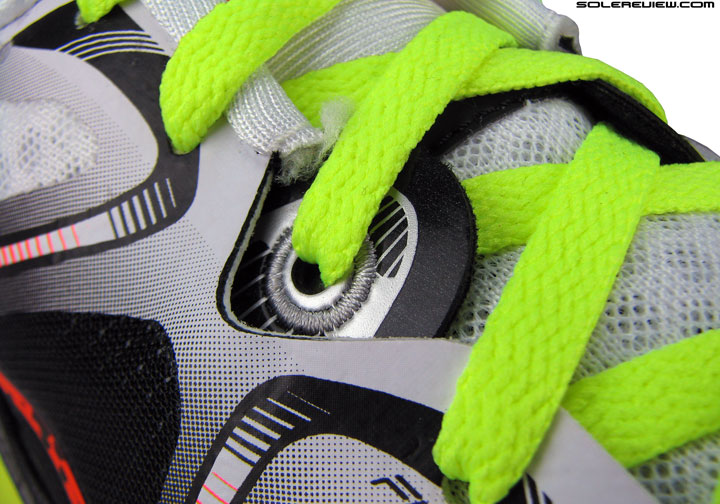
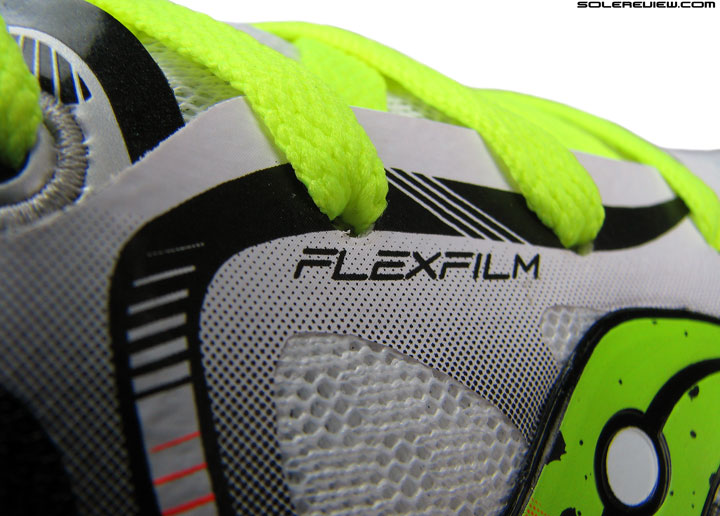



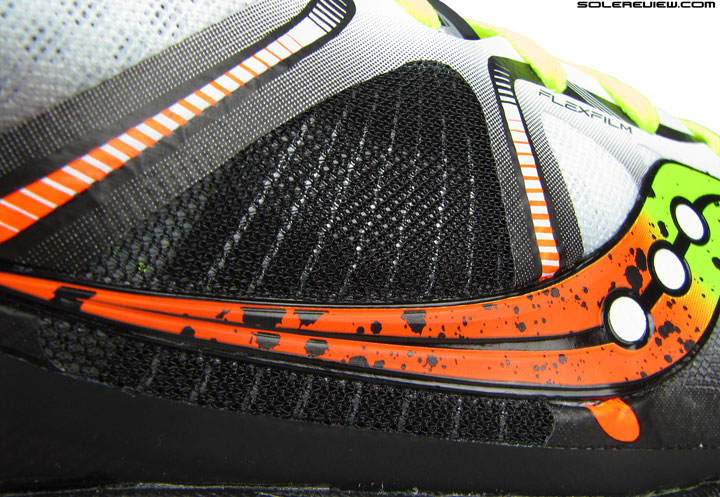


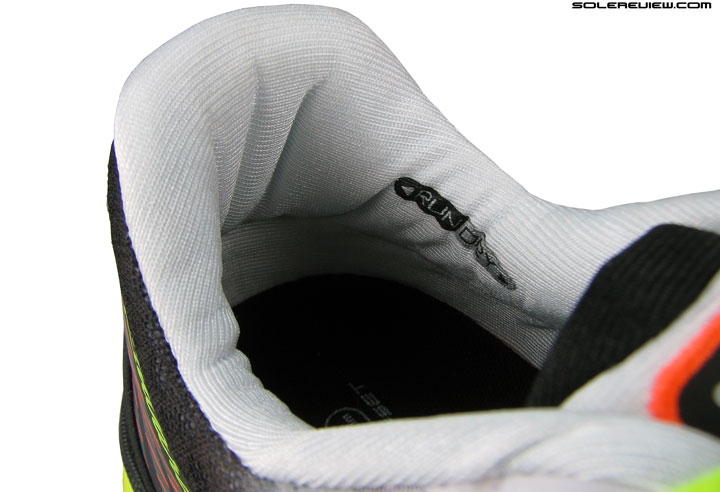

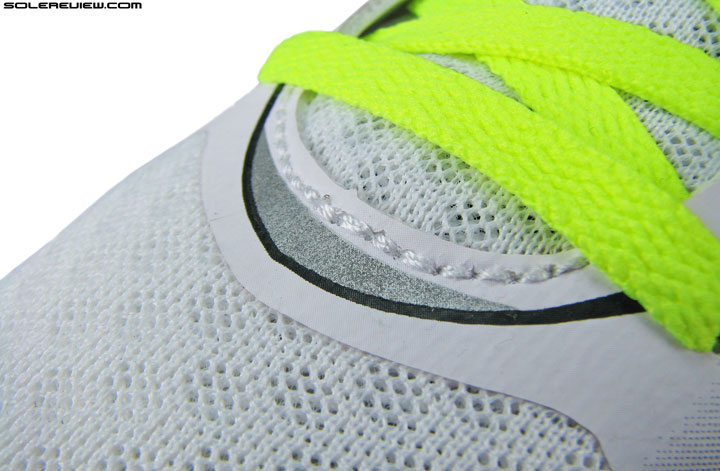
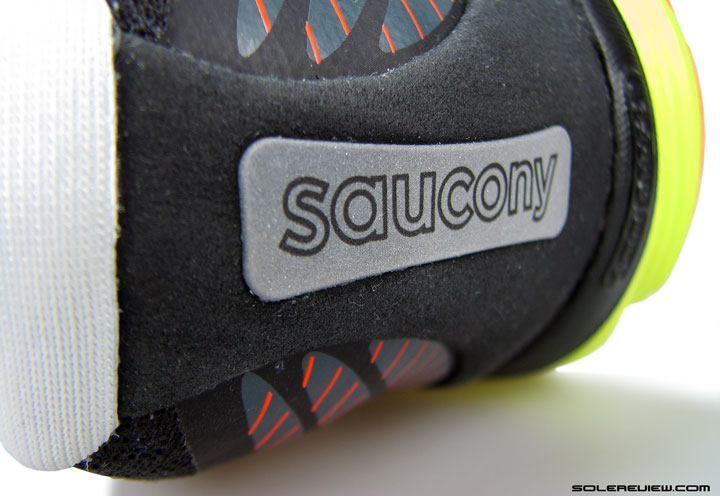

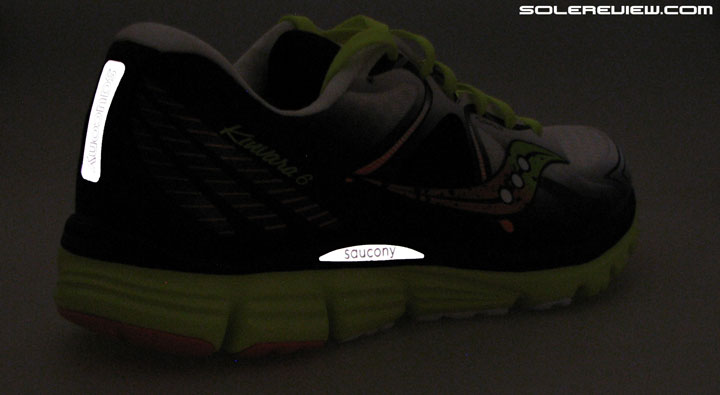

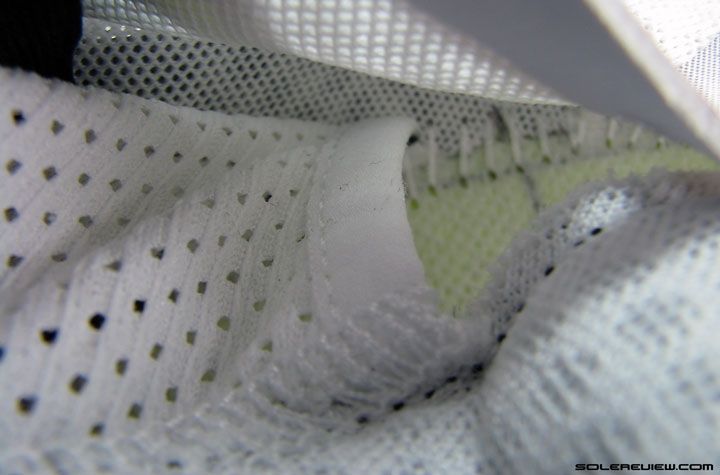
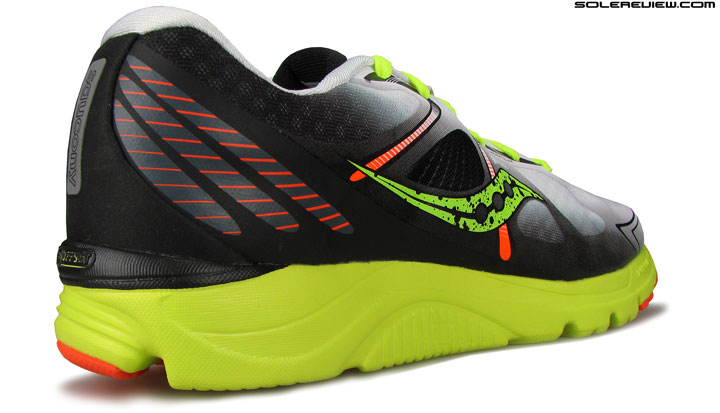
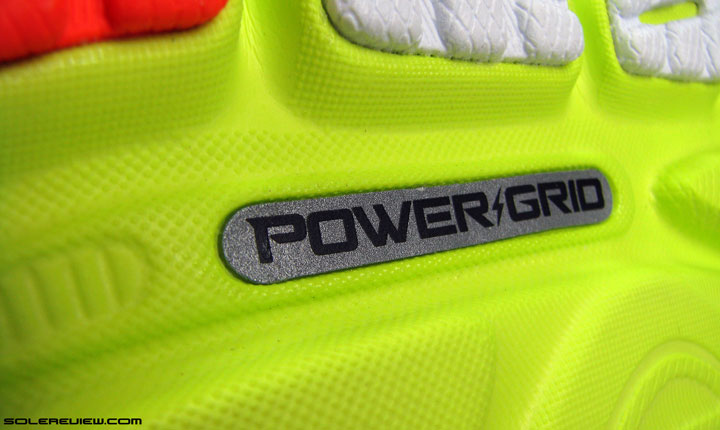







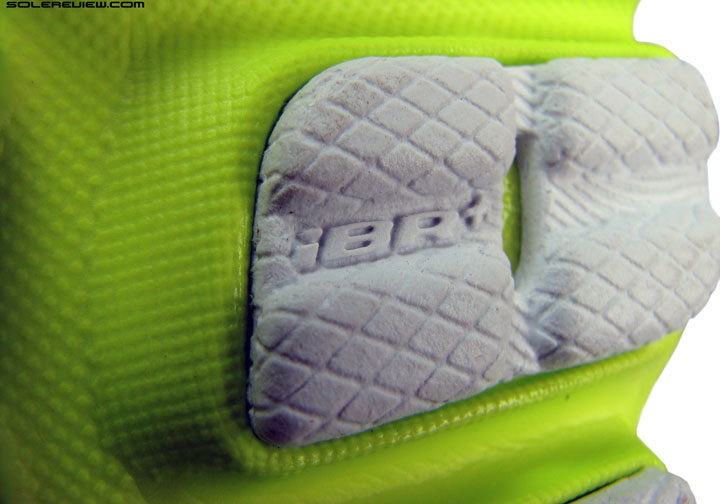



43 comments
Great review. And your Kinvara 5 review was the only review that I came across (and I read a lot of reviews) that correctly identified how much softer the Kinvara 5 is compared to previous models. I found all the other reviews maddening (“great update!”, “Kinvara lovers will love the new 5”, etc etc) as they somehow missed that the shoe had radically changed. Yes, I’m like Bill and Amy as I’m heartbroken by what Saucony has done to the Kinvara. They’ve ruined the shoe for me. And I’m not exaggerating when I say that I’ve bought more than 40 pairs over the last 5 years (I run relatively high mileage and I recently bought something like 8 pairs of the Kinvara 3 and 4 at discounted prices to hold me over).
Can you give me your thoughts on close alternatives? I like a lower-drop shoe that is light and firm, but don’t feel like I can wear a true flat (e.g., Saucony A6) for all of my training. Based on your comment in this review, I will take a look at the Hoka Huaka. Pearl Izumi Road N1 is on my list to try too. I’ve tried and haven’t liked the NB Fresh Foam Zante, Brooks Pure Flow and Asics DFA 33. Anything else that I should be trying? Many thanks!
That’s a lot of backstock, and a smart move at that.
The Hoka Huaka is good, but the upper fit feels a bit off when compared against the Kinvara 3 and 4. It remains an option you can try, however. How about the Nike Lunar Tempo, given that a go yet? And the adidas Boston 5?
Not sure how Pearl Road N1 fares, haven’t started testing Pearl Izumis yet.
What a great sunday morning – first thing I did this morning was looking at some travel pictures and then I had the feeling that maybe the K-6 review might be up… and what did I see – a travel story :) Fantastic writeup – I really appreciate that narrative around the shoe!
It´s interesting that shoe companies are so opportunistic (backboneless) in following every silly trend without concerns of sacrificing some of their core qualities and repelling at least some of their customers on the way. Why can´t the Kinvara be a firm and snappy shoe? Does it really have to feel soft(erer) – they should have made the Zealot for that – but even screwed that one up.
I ran in the K-3 (that I bought too small) and K-5. The best thing about the K-5 is that it fits my foot, although I tend to slide forward on downhills and I can feel some hard edges at the side of my big toes. I like the puffy tongue because I use every eyelet to secure the heel and don´t want to feel lacing pressure. The heel is ok, maybe not too secure but nothing like the Sayonara 2 that causes me major heel slippage and aggravates my heel bones.
I don´t have problems with the pro-lock “system” but don´t really understand that approach. It´s not needed. Heck, I don´t even like the iso fit – not in the Triumph, not in the Zealot. These shoes fit small and it reduces breathability. I just don´t like that tight wrap of material around my foot.
The K5 doesn´t feel overly soft to me (talking about the forefoot). If it´s new, it feels stiff (that´s due to the upper too) and plasticy – transition (forefoot strike) feels somewhat jarring. If it´s well worn it gets softer and better feeling but looses it´s mild snappiness. K-5 just feels clunkier and it´s harder to run in than the weight might imply.
So let´s be hopefull towards the K-7. Happy sunday :)
I resurrected my old K-3 and to my surprise they seem to have more spring than the K-5. Could this be true or is it just in my mind? (I have th K-3 in size 10.0 wide and K-5 in 11) How? There is no PowerGrid in the forefoot, right?
Thank you for the detailed insight about the shoe! The issue with aligning a model too much with the bigger theme is that it loses the individuality which made it popular in the first place.
We had a lot of travel pictures (really, a lot), so thought of doing something new. Glad to know you like the experimental format.
Great review! Interesting how the K1 was originally “nothing more than you need” yet 5 years later it follows the trend of increased softness. Would the new kinvara actually have decreased durability due to the softer eva durometer?
Thanks! Always hard to say how beforehand (or if) a lower durometer results in decreased durability. Nike Free’s are a good example, the nearly all-foam outsole rivals many rubber clad models when it comes to long term wear.
If it´s not too much off topic, I could poste some pictures of my K5s to show the wear after 7 month – I suppose that durability hasn´t changed a lot compared to the K6.
That would be great! Do that!
So, here we go… The K5s have roughly 300-350 miles on the clock. My runs are on average 9-10 miles long with maybe 3 miles on concrete, rest forest (beaten) paths, gravel, fireroads – nothing that I would call technical trails. I weigh 65kg at 1.76m height. Over time the upper and outsole has molded to the shape of my feet. The midsole has become much softer and a little worn out in the forefoot (I can feel a recess in the footbed and the outsole seems to have gotten wider with use). That being said, they still feel good but I wouldn´t do any long runs (anything beyond 13 miles) in them anymore. The heel looks that good bc I´m a forefoot striker. All in all, the K5 is not a very durable shoe (at least for me) – depending on running style and surface. With all my shoes the lateral forefoot shows much higher wear. That´s not the shoes´ fault though – the roads and paths I run on are not level but more beveled in a concave way. I tend to run on the right side of the road so my left shoe hits the ground more on the lateral edge of the forefoot and I tend to supinate a little too.
Right now I´m in a bit of a dilemma cause I have to decide whether I buy a new pair of K5s or the much more expensive Nike Vomero 10 (surprisingly nice shoe – fits great in same size as Kinvara, fantastic upper and forefoot cushioning, only concern is outsole durability of the soft forefoot rubber and maybe a slight clunkiness).
But despite me ranting about them the K5 is nonetheless a nice shoe – comfortable, good looking, reasonable fast, light etc. For reference I´ll poste pictures of my Skechers Gorun Ultra at 450 miles and Asics Nimbus 15 at 600 miles.
Oh – I´ll have to downsize the images… will do that later.
That’s a lot of detail with regards to your usage, thank you for sharing. And for the pictures too!
The Kinvara’s forefoot rubber coverage is minimal so the wear is not entirely unexpected, considering your strike pattern. As regards your next purchase, have you also considered the Breakthru or the Ride?
The Vomero 10 is a great shoe, though not in the plush way many expect it to be. It is a very different Vomero. The Nike should be more durable than the Kinvara, that brand has their rubber compounding down pat.
I simply assumed that the information was necessary to assess the pictures. Otherwise they would be quite meaningless as wear is a function of individual usage in a certain environment.
In regards to the shoes, thank you for these suggestions. Unfortunately both the Breakthru and the Ride (7) are tooo narrow in the toebox for me and I can´t get the 2e version of the Ride in my country. The Vomero 10 fits wonderfully though. Great toebox, even wider than the one of the Kinvara, secure fit – flyknit upper works great for me and the forefoot cuchion feels responsive.
K5 – I´m surprised by the wear and tear. The shoe feels better than it looks.
Here the more durable Skechers GRU.
And the even much more durable Asics Nimbus 15.
Hi, I have a high arch but i don’t think its too high and i supinate.
Do you have any recommendations for running shoes?
I don’t have much experience in buying running shoes but I own a old pair of asics nimbus 14 and i really liked it.
But from what I’ve been reading the nimbus is a very heavy shoe?! Didnt think so when i wore them…
Also correct me if i’m wrong, but high arches do not need any support in shoes?
If so are there lighter shoes for my feet that you can recommend?
If you liked the Nimbus, makes sense to stick to a similar model. The latest Nimbus 17 is much softer, so the closest Asics (based on what we’ve reviewed) to the N-14 is now the Cumulus 16. (The Cumulus 17 has also been released).
As far as the whole thing about arch type vs. shoe category is concerned, don’t think too much of it. Go with what feels best and fits comfortably.
I’m a forefoot striker that keeps wearing out the outsole around my big toes after 150 miles in Brooks Ghost 7. I’m looking at this and the PureFlow as potential next shoes, hoping a more natural drop will be better suited to my running form, but you mention this one also has a less-than-stellar reputation for forefoot durability.
What would you recommend for a forefoot striker? I’m heavy, 190lb, and while my form is pretty good I do plan to figure out if I’m dragging my toes.
I run 20 miles a week, usually 8-9 is my long run. I am doing my second half marathon in September.
Also, this is the best shoe review I have ever read!
Thank you for the comment! The New Balance Zante, Boracay and the Skechers GoMeb Speed 3 are worth a look as lower heel drop options, based on our pool of reviews. If you are buying the Pureflow as well, then we’d think the Boracay to be a good pairing.
Clearly you’re a magician: the running store ended up setting me up with the Boracay! Compared to the PureFlow my footstrike was much softer and better balanced at midfoot/forefoot, whereas I was slapping my toes around with PureFlow.
It took me a few runs and quite a bit of fiddling to get the Boracays laced just right, as they have quite a lot of heel slip for me (narrow heel, very wide forefoot, one small foot). But today was my first good run in them and now that they’re broken in I think they’ll treat me well!
Best comment ever! Happy to hear you found a shoe which you liked, and thank you for sharing your feedback.
Swell Boracay color too.
Hi, great review as always!
I’m a forefoot striker and I’m looking for a shoe for daily 5-10K runs.
I’m thinking about the Saucony Kinvara’s, can you point me in the right direction? Thanks!
Yes, these work well for forefoot striking within your stated mileage. Also try the Nike Zoom Elite 8 if you’re ok with a firmer ride and higher heel to toe drop.
Why did Saucony have to ruin the 3 and 4? That was my go to trainer, but now I train in the Fastwitch because of it. I’m really hoping they go back to the design ideals of the 3 and 4.
I have Kinvara 4 and i absolutely love them! I run them to the ground but Im contemplating on purchasing another kinvara especially the new version because of some issues. Kinvara 5 upper tears so easily and the cushioning is a tad different from the previous models. And now Kinvara 6 in which i learn is a world of difference with the older one. I hope Saucony will get it together and stick whats is generally loved by runners! Kinvara 3 and 4 cushioning shouldn’t be touch and kinvara 2 upper is far better than the newer models.
Appreciate the insights, and great to see you here after a long time!
Might be worth waiting for the Kinvara 7, which should come with more than a few changes. You’re right, the Kinvara 5 and 6 are quite different from K-3/4
Yeah as always a great review overall. Im frustrated with Saucony i ran my first race with tge Kinvara 4 and I had a blast but unfortunately the durability is not that great. After reading so much reviews on the 5 and 6 im hesitant to get back to Kinvara as my main shoe. I guess 7 would correct all the mistakes Saucony made on the past iteration. Thanks! Good read as always.
One can only hope!
awesome review i must say!! KUDOS!!!
But i am not sure whether they are meant for me. I zeroed on to them courtesy a shoe finder wizard. I strike forefoot on tempo runs and mid-foot on long runs, weigh 152 lbs, normal pronation. I give pace of about 8 min/mile on long runs. Is kinvara 6 is the right choice or something else is better? I recently had issue with my Plantar and it has been two months. My earlier shoes were Puma Faas 300 and Nike Free 5.
Hello Sukhi,
Thank you for the comment!
You might want to try the New Balance 1500 V1, Nike LunarTempo and the New Balance Fresh Foam Zante before you do the Kinvara.
Hi, GREAT REVIEW!
I’m currently using Triumph ISO for long runs since I got blister on my left toe from Sketchers Go Run Ride but had helped me to improved my running and transfer to midfoot striking and Type A5 for sprints. I run average 18KM/ week 68kg and training for 70.3 Triathlon. I want to use the Kinvara as my race day shoe for the run (21KM). Will it be advisable for this distance or stick with Triumph which is heavier and more cushioned.
Thanks
The Kinvara 6 is nice for a half marathon, but if you’re doing well in the ISO, why change?
just an update. I just had a blister again on my right toe wearing the Triumph ISO, after my 11th km, i felt the burn on my toe. i never felt this on my New Balance 1080 V3. any comment why i’m getting this.
Can’t say for sure. Shoes fit and behave differently based on the runner. Are the insides of the ISO rubbing against your toe? If so, you need to find a shoe with a wider toe-box/forefoot.
The Nike Vomero 10 is in the same category as the ISO, and has a wider forefoot/toe-box.
thanks for the advise. I think my toe is not rubbing as I’ve suffer same thing with my Sketchers GRR with wider toe-box. i’ll give a little more time for my triumph, if nothing changes then i’ll give the Vomero 10 a try as it has great feedback from your review as well. really appreciate your help. more power!!!
Thanks for the update, Myke!
Comments/Q&A section will be closed till January 17, 2016. Any inconvenience is regretted. Premium access members can continue to use their dedicated comment thread, which will be open.
Just thought I’d share an image of a medal presented to participants in the annual Kinvara Rock and Road half marathon and 10K Road Race. Kinvara is a small seaside town in Galway in the west of Ireland.
This review expresses every feeling in my heart toward the Kinvara and much more. I couldn’t stomach the 5s (something about the heel-upper was uncomfortable) and stocked up on cheap K4s (why anyone let them go for south of $50 is insane to me). But you can only stock up on so many pairs of your favorite shoe, and I eventually ran out.
The K6 fixed whatever was bugging me in the upper about the K5. But why did they make it so soft? I used to race in my old Kinvaras, but this version feels too squishy for racing anything but a marathon.
Anyway, no questions, just wanted to voice solidarity with the “bring back the old Kinvara” campaign.
There’s a reason why we wrote this long-winded (and rather unconventional) shoe review. Thanks for the feedback!
Great review! I’ve been using the Kinvara’s since the three’s and have actually preferred the more recent iterations. I’m looking at getting a shoe that is more suitable for interval training/shorter distances and keep my Kinvara’s for my longer runs, any suggestions?
Yes! Try the New Balance 1500 V1 or V2, adidas adios 3 Boost, Nike Lunaracer 3 or the Nike LunarTempo.
Comments are closed.